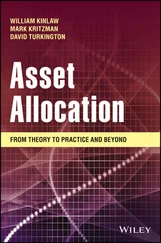David M. Berns - Modern Asset Allocation for Wealth Management
Здесь есть возможность читать онлайн «David M. Berns - Modern Asset Allocation for Wealth Management» — ознакомительный отрывок электронной книги совершенно бесплатно, а после прочтения отрывка купить полную версию. В некоторых случаях можно слушать аудио, скачать через торрент в формате fb2 и присутствует краткое содержание. Жанр: unrecognised, на английском языке. Описание произведения, (предисловие) а так же отзывы посетителей доступны на портале библиотеки ЛибКат.
- Название:Modern Asset Allocation for Wealth Management
- Автор:
- Жанр:
- Год:неизвестен
- ISBN:нет данных
- Рейтинг книги:5 / 5. Голосов: 1
-
Избранное:Добавить в избранное
- Отзывы:
-
Ваша оценка:
Modern Asset Allocation for Wealth Management: краткое содержание, описание и аннотация
Предлагаем к чтению аннотацию, описание, краткое содержание или предисловие (зависит от того, что написал сам автор книги «Modern Asset Allocation for Wealth Management»). Если вы не нашли необходимую информацию о книге — напишите в комментариях, мы постараемся отыскать её.
provides the knowledge financial advisors and their robo-advisor counterparts need to reclaim ownership of the asset allocation component of their fiduciary responsibility. Wealth management practitioners are commonly taught the traditional mean-variance approach in CFA and similar curricula, a method with increasingly limited applicability given the evolution of investment products and our understanding of real-world client preferences. Additionally, financial advisors and researchers typically receive little to no training on how to implement a robust asset allocation framework, a conceptually simple yet practically very challenging task. This timely book offers professional wealth managers and researchers an up-to-date and implementable toolset for managing client portfolios.
The information presented in this book far exceeds the basic models and heuristics most commonly used today, presenting advances in asset allocation that have been isolated to academic and institutional portfolio management settings until now, while simultaneously providing a clear framework that advisors can immediately deploy. This rigorous manuscript covers all aspects of creating client portfolios: setting client risk preferences, deciding which assets to include in the portfolio mix, forecasting future asset performance, and running an optimization to set a final allocation. An important resource for all wealth management fiduciaries, this book enables readers to:
Implement a rigorous yet streamlined asset allocation framework that they can stand behind with conviction Deploy both neo-classical and behavioral elements of client preferences to more accurately establish a client risk profile Incorporate client financial goals into the asset allocation process systematically and precisely with a simple balance sheet model Create a systematic framework for justifying which assets should be included in client portfolios Build capital market assumptions from historical data via a statistically sound and intuitive process Run optimization methods that respect complex client preferences and real-world asset characteristics
is ideal for practicing financial advisors and researchers in both traditional and robo-advisor settings, as well as advanced undergraduate and graduate courses on asset allocation.












